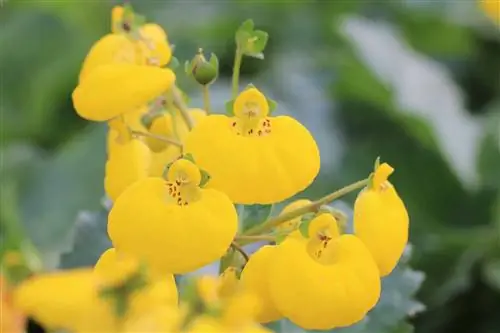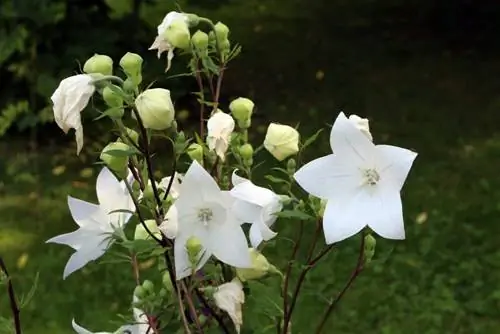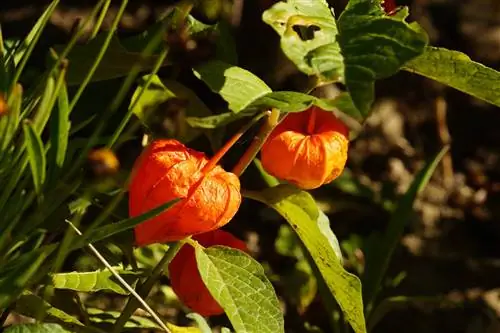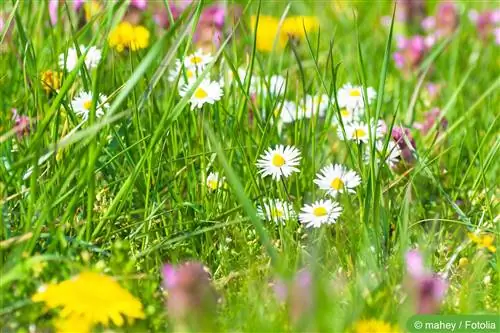- Author admin [email protected].
- Public 2023-12-17 03:39.
- Last modified 2025-01-24 12:45.
Around 300 species are known of the slipper flower with the Latin name Calceolaria. They are shrubs or perennials, are annual or perennial and are suitable as garden flowers, balcony plants or houseplants. Depending on the species, slipper flowers can reach a height of up to one meter and a width of up to 30 cm. Annual Calceolaria hybrids find their place in the room. They are particularly characterized by large flowers. Slipper flowers for the garden tend to have small flowers, but they bloom in greater numbers. The annual plants bloom in April. The perennial plants open their flowers from mid-May.
Location/Soil
Calceolaria hybrids require a bright, partially shaded location with cool temperatures. Indoor plants tolerate direct sun worse than outdoor plants. For a full bloom in the garden, the garden slipper flower needs a place protected from the wind and a certain level of humidity. The slipper flower gets along well with normal garden soil. It can be low in lime and have a slightly acidic environment. Good drainage ensures that irrigation water runs off. By the way: the warmer the plant is, the faster it will wither.
Sowing
The slipper flowers take five months from seed to flower. Slipper flowers for the garden should therefore be sown in December. Slipper flowers are light germinators. Therefore, the seeds are simply placed on the growing substrate and pressed lightly. The substrate may be slightly humus. Keep the seeds slightly moist at a temperature between 15°C and 18°C. The germination period is two to three weeks. The seedlings grow best at a temperature between 12°C and 14°C. Pricking out into individual pots takes place when the plants are around 10 cm high. From mid-May after the Ice Saints, the little slipper flowers can move outdoors.
Tip:
Cool temperatures around 10 °C ensure abundant bud formation during growth!
Plants
Slipper flowers are planted in the bed with a planting distance of 30 cm. The planting depth is around 10 cm to 15 cm. A handful of compost in the planting hole provides the slipper flower with nutrients throughout the entire season. Garden slipper flowers grow to around 50 cm high. The yellow slipper flower is an eye-catcher in front of dark hedges and trees. It is suitable for underplanting and for perennial beds and borders.
Pouring
The slipper flower needs a lot of water, but without drowning in moisture. The water should drain easily. For plants in planters, the saucer is checked after around 30 minutes so that the slipper flower doesn't get its feet wet. On hot days, the slipper flower needs to be watered early and in the evening. Flowers and leaves should not be wetted with drops of water. Otherwise they will become stained. If the leaves of the slipper flower hang sadly, then this is a sign of a lack of water.
Tip:
Place dried plants with the plant pot in a bucket of water for a short time so that the roots can soak up. If there is a lack of water, garden slipper flowers are watered several times in a row at short intervals so that they recover.
Fertilize
Slipper flowers react to too much fertilizer with yellow leaves. They prefer a rather lean planting substrate. Therefore, fertilize the plant sparingly rather than too much. Adding fertilizer during flowering ensures well-developed flowers. To do this, use commercially available liquid fertilizer every two weeks. In the garden, organic fertilizer material such as compost or horn shavings can be incorporated around the plant.
Care
Remove spent flowers, leaves and plant parts. This prevents pest infestation and keeps the plant he althy. Calceolaria hybrids may then bloom again. In addition, the plant grows back stronger.
Note:
The slipper flower does not require pruning.
Propagate by cuttings
In addition to growing from seeds, slipper flowers can be propagated from cuttings in the fall. The cuttings are taken in autumn from dead mother plants and placed in a substrate made of peat substitute and sand. At temperatures around 20 °C, the roots take around two weeks to form. The roots appear where the cutting previously had leaves. Calculate the length of the cutting accordingly.
Propagate by division
Perennial Calceolaria species can be propagated by dividing the root ball. To do this, the plants are carefully dug up and the root ball is divided into evenly sized pieces. Division is possible in autumn and spring.
Wintering
Slipper flowers are evergreen. Hardy species are covered with brushwood to protect against frost. Perennial potted plants are overwintered in a greenhouse or in a frost-free room at around 10 °C.
Tip:
Ensure there is sufficient brightness in the winter quarters so that photosynthesis can function.
Diseases
In unfavorable locations and when care is made incorrectly, Calceolaria hybrids are often affected by diseases:
- Grey mold is caused by too much nitrogen-containing fertilizer or too high humidity. It is characterized by a gray coating on the leaves and flowers. Remove the affected plant parts and ensure good ventilation.
- Aphids and the whitefly appear in a location that is too warm and too dry. Aphids can be controlled with a mixture of nettles or a mixture of soft soap and alcohol. An insecticide from specialist retailers helps against whiteflies.
- Snails eat slipper flowers bare within a short time!
Tip:
Many diseases can be avoided by a bright, airy and cool location!
Known varieties
In contrast to some other types of slipper flower, the garden slipper flower (Calceolaria integrifolia) is perennial and, in its wild form, grows as a small shrub that can reach more than a meter high. However, the cultivated varieties of the garden slipper flower usually only reach a height of around 40 centimeters. With these varieties, the flowering period takes a little longer and can last until autumn. If it has already bloomed, pruning it back may stimulate new blooms.
The garden slipper flower can be propagated via cuttings. These cuttings are cut in autumn after flowering and placed in pots with potting soil. They overwinter in a bright and cool room and can be planted out in the garden next spring. This propagation and overwintering is not worthwhile for indoor slipper flowers, so it is best to sow them again every year.
- Calceolaria cavanillesii is a hardy perennial about 30 cm high. It shows its yellow flowers between June and July.
- The showy Calceolaria arachnoidea has purple flowers and white leaves. It is hardy and blooms between June and July.
Frequently asked questions
Which varieties are best suited for outdoor use?
These include the slipper flowers 'Goldbukett', 'Goldari', 'Sunset', and 'Sunshine'.
Does overwintering the slipper flower make sense?
Annual slipper flowers only bloom once. Overwintering is not worth it. It's different with the garden slipper flower. It will sprout again next year.
What you should know about the slipper flower in brief
Sowing
- Slipper flowers can be grown from seeds as early as winter so that they reach the right size in time for the balcony season.
- These seeds are usually annual varieties that die after flowering.
- Slipper flowers are light germinators, so the seeds should only be pressed lightly into the sowing soil, but not covered with soil.
- The pots are then placed in a shady place where the seeds are protected from direct sun. The temperature there should be a maximum of 15° C.
- After sowing and in the following period, the soil is always kept slightly moist.
- It takes about two to three weeks for the first plants to appear. When fully grown they are about 30 cm high.
Care
- The slipper flower needs a bright location, but should not be in the blazing sun, otherwise it will soon wither.
- It also doesn't like high heat and thrives best at temperatures around 15° C.
- Your pot ball should always be kept slightly moist. However, it cannot tolerate waterlogging. Remove excess water from the planter after watering!
Fertilize
- So that it produces many flowers, it can be fertilized during the summer months with a conventional fertilizer for flowering plants.
- Their flowering period begins in May and lasts about four to eight weeks. Removing wilted flowers stimulates the formation of new flowers.






